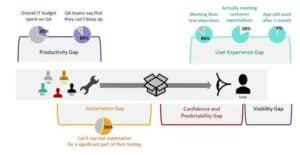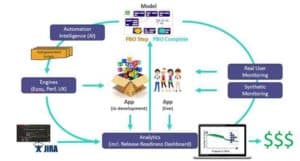For a while now (about 10 years), Dev and Ops have been trying to get along. After all, collaboration between the two creates fast feedback loops and gets high-quality software into users’ hands faster. But with a new space emerging, digital experience management, Dev and Ops need to make a new BFF—the business—to stay in sync.
There are a few key ways to achieve BizDevOps.
The first has a lot to do with smart monitoring, testing the end-to-end digital experience, and learning and enhancing dynamically from monitoring and testing feedback. Imagine intelligently analyzing your app to create a model of system and user journeys. Then using an AI-based model to analyze the model, along with real data about how the app is used, to then automatically create test cases that provide strong coverage of the UX, performance, and functionality of the system. This radically improves automation, time to market, and test coverage.

Figure 1: The need for change
Digital Automation Intelligence + Monitoring
Now, however, consider extending this model by relating user journeys to desirable, positive business outcomes. Examples can be e-commerce conversions in a retail app, which translate directly into revenue, and completed healthcare processes in a hospital, which can equate to lives saved. Just think about the possibilities.

Figure 2: Digital Automation Intelligence and Monitoring
But how do you achieve this?
First, by employing the right predictive analytics techniques, it’s possible to predict not just whether the software will work but how well it will do in addressing business objectives.
Second, don’t stop there. It’s possible to use techniques developed in real user monitoring to continue to continuously test the app in production. You can do this by tapping into the transaction flows of real users and relating these to the user journeys and whether they’re ahead of or behind desired targets.
For example, determining how every user coming to your website or mobile app is finding things, adding items to their carts, and checking out. You can see, for instance, that only 1 in 10,000 of site users are actually making purchases, compared to the expected 1 in 5,000. Then—and here comes the really smart bit—feed that data back into the AI model and learn from it dynamically. Generate new, focused tests to zoom in on the problem and see if there’s a specific UX, functionality, or performance issue that can be identified that might explain the under-performance. And then recommend a remedy that could address it. Is the UX too complicated, is the site too slow, or is there a functional error? In these ways, the model learns from monitoring, from real users, and from testing. Using an AI model to automate testing and monitoring benefits the business and enables BizDevOps because you can use the data to spot shortcomings, address them, and determine tangible business outcomes—all within the same framework.
The third way to achieve BizDevOps involves synthetic humans. Right now, teams use synthetic monitoring to assess what kind of experience a real user would be getting from an app. A synthetic user connects to an app and uses it just as any user would, while recording and analyzing the experience. But imagine creating synthetic users with different personalities to test a website or an app under real load. The senior citizen in Zurich shopping online; the millennial in Vienna who likes mobile; the middle-aged plumber in Berlin who likes buying vintage watches. What if you could deploy 10,000 synthetic users of each demographic to experience the app and the UX. From the data and the learning model, you could figure out that seniors aren’t buying because the text on your buttons is too small. Forty-something watch enthusiasts are looking and leaving because of a limited product selection. The millennials are buying loads because they like your simple mobile UX.

Figure 3: The 5 Principles of Digital Automation Intelligence
To thrive in the digital experience economy, you need to stop testing at the code level and start testing from the true user perspective. Integrated solutions can use AI, machine learning, and analytics to recommend tests to carry out, learn continuously, and perform intelligent monitoring that can predict business impacts and enable development teams to fix issues before they occur. So you can shrink time to market, delight customers, reduce risk by monitoring and testing the end-to-end user experience, improve conversion and retention rates, and drive revenue.
[toggle type=”Autor” title=”Autor”]See for yourself how Testplant solutions can help you make BizDevOps a reality at your organization what is exactly what our Digital Automation Intelligence Suite and approach does. Request a demo today.
Written by John Bates
Dr. John Bates is the CEO of Testplant, a visionary technologist and highly accomplished business leader. He’s also the author of the book “Thingalytics: Smart Big Data Analytics for the Internet of Things.”[/toggle]

0 Kommentare